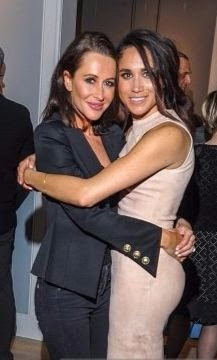 |
| Spot the difference? |
The actress is a direct descendant of England's King Edward III, who ruled from 1327 until 1377, according to genealogist, Gary Boyd Roberts. That technically makes her and Harry 17th cousins.
According to the research, Markle, a Los Angeles-born American citizen, is a 24th generation descendant of King Edward III. The lineage was discovered through Rev. William Skipper, a royal descendant who arrived in New England in 1639. He's an ancestor of Markle's father, Thomas Wayne Markle.
 |
| Thomas Markle and his little princess |
 |
| Markle and Ragland families |
Scientists say a “possible question mark” over the lines of succession in the medieval monarchy could break the bloodline between Richard III, in the 16th century, and Henry Somerset, who died in 1803, although it is “far more likely” to be found nearer the medieval period.
No match has been found between the DNA of Richard III and his existing paternal relatives. Experts have no evidence of precisely when the break occurred, but believe it would affect the claims to the throne of the Plantagenets rather than more modern Royals.
 |
| Apparently, allegedly, Princess-to-be Meghan and her lesbian lover in Toronto recently! |
“There are 19 links in that chain, so there is an equal probability of any one of those 19 being broken. From a historical view point, where the break occurred has differential consequences.
“There are five links in that chain between Richard, up through Edward, and then to John of Gaunt. And then the remaining majority of the links are down through the Somersets and the Beaufort line.
“Now if - and it is a very big if - the break in the chain is one of those five, between John of Gaunt and Richard III, historians could ask questions - theoretically - about the inheritance of a number of the Plantagenet monarchs.
“And since Henry Tudor’s mother was also a Beaufort descended from John of Gaunt, there is a question here too.
Schürer, who specialises in English Local History, and Dr Turi King, from the university’s Department of Genetics, reaffirmed the momentous evidence that the body found under a Leicester car park was Richard III.
“Our paper covers all the genetic and genealogical analysis involved in the identification of the remains of Skeleton 1 from the Greyfriars site in Leicester and is the first to draw together all the strands of evidence to come to a conclusion about the identity of those remains,” reflects Dr King, calling the project “an over 500-year-old missing person’s case.”
“Even with our highly conservative analysis, the evidence is overwhelming that these are indeed the remains of King Richard III.
“The fact that we do not find a match between the living male-line relatives and the skeletal remains is not at all surprising to me.
“We knew from work that I, and others, have carried out in the past that the incidence of false-paternity, where the biological father is not the supposed father, is historically in the region of one to two percent per generation.
“Even using a conservative rate, we knew there was a 16 percent chance of finding there would be a false-paternity in this chain.”
Richard “probably” had blond hair and “almost certainly” saw the world through blue eyes, bearing a resemblance similar to one of the earliest portraits of him, held by the Society of Antiquaries in London.
“The break in the Y-chromosome line is not overly surprising given the incidence of non-paternity,” echoes Professor Schürer.
“But it does pose interesting speculative questions over succession as a result.
“Especially important is the triangulation of the maternal line descendants.”
The findings have been published online in Nature Communications - Culture24 Online.
Meghan Markle’s great-great-great grandfather chose a new surname after slavery was abolished in 1865. According to Harper’s Bazaar, Meghan wrote in an essay about her mixed-race heritage in 2015…
"Perhaps the closest thing to connecting me to my ever-complex family tree, my longing to know where I come from, and the commonality that links me to my bloodline, is the choice that my great-great-great grandfather made to start anew. He chose the last name Wisdom. He drew his own box.”


















2 comments:
Juicy...
I wonder if you have looked at all at the status of the Spanish royal bloodline?
Hi Maria
Thanks! No, I only know a little about Spanish royalty, I do have first-hand experience of Dutch Royalty (wrote about it once, a long time ago on this Blog!) but I am looking into all sorts of things right now. My father is always going on about our bloodline... it's a big joke at the moment, but that's for another time!
Is there something interesting with the Spaniards I wonder?
After this latest Royal Wedding saga, I have found more things that I'd like to talk about and dissect!
Post a Comment